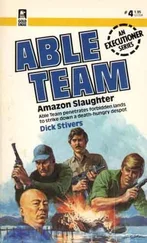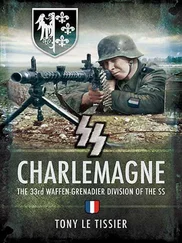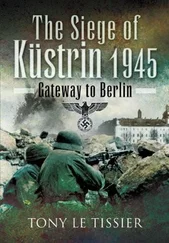As SS-Lieutenant Bärmann of the 32nd SS Tank-Hunting Battalion recorded:
The order to break out came towards evening. The remains of the 32nd SS Tank-Hunting Battalion were to form the rearguard. As our guns could only fire forwards, that meant us driving backwards for over 60 kilometres. [13] Tieke, Das Ende zwischen Oder und Elbe , p. 315.
SS-Colonel Hans Kempin, commander of the 32nd SS Division, also described the position:
My last contact with General Busse was by radio, during which he informed me that he was trying to find a gap in the encirclement near Potsdam through which he could take headquarters 9th Army out of the pocket. He instructed me to take over command of the individual reachable units as a rearguard and to decide myself whether to break out to Berlin or towards the Elbe [12th Army]. On receipt of these orders, I saw myself having to stop the last counterattack by [omission in original] and his battalion, disengage and arrange the handover of the main dressing station with about 2,000 wounded to the Russians…
When I and my staff reached a clearing in the woods before Halbe, I found several thousand soldiers there who had given up, lots of burnt-out tanks, buses, trucks and so on. The general view was that going any further was impossible. I therefore had another row with Jeckeln, the then commanding general of V [SS Mountain] Corps.
I ordered the commander of my headquarters’ security company, Fahland, to stay there and went on with my staff to Halbe during an air raid, and got through. There was no one to be seen, but plenty of corpses. Braun then went back to fetch the company. From your description, I take it that we had come from the Hammer forestry office.
I can still recall a shot-up truck behind Halbe that must have been carrying pay, for the notes were lying around on the ground and no one had seen to them. [14] Letter to Dr Lakowski, cited in Lakowski/Stich, Der Kessel von Halbe 1945 , pp 182–3.
Artillery Regiment Kurmark and the remaining heavy weapons were ordered to fire a barrage on Halbe with the last of their ammunition at 1800 hours. After that their equipment was to be destroyed. All units were to take only the most essential vehicles, all the remainder having to be destroyed after their fuel tanks had been emptied for the use of the armour.
The materiel strength of these spearheads was relatively weak. The 502nd SS Heavy Panzer Battalion had probably only 14 of its formidable Tiger II (Königstiger) tanks left. [15] These tanks are referred to indiscriminately by witnesses as either Tigers or Königstigers. Schulze, Der Kessel Halbe–Baruth–Radeland , p. 83 supplies the following information: ‘The exact number of Tiger IIs available near and in Halbe cannot be established due to the varied and conflicting accounts. The strength return for the 502nd at Klein Hammer gives seven each for the 1st and 2nd Companies, but already here the figure of seven for the 1st Company is doubtful. Tieke, Das Ende zwischen Oder und Elbe , gives 14 in Halbe, Scholz counted 12 in Halbe at night. Führling, Endkampf an der Oderfront , says 13 and Streng/Ott seven. Even the standard works have doubts, so that one must enquire about each tank: was it really a Tiger, or in fact a Panther? Thus three Tigers were listed as casualties in or near Halbe, Kuhnke (211), Harlander (213) and Münster (214). Apparently a further two Tigers were lost between Halbe and Löpten. Steng/Ott’s account of seven refers to Massow, where Schneider gives five, two having become stuck crossing the autobahn and having to be blown up. Thus two tanks were lost, one of them Kämp’s (123). Of the six Tigers of the 502nd in Massow early on 29 April 1945, we have the following fates: Hellwig’s 222 was ordered by Streng to secure the Reichsstrasse 96 crossing to the north towards Wünsdorf. Hellwig came back without it, the Tiger having had to be blown up by Neuhof. Pott’s Tiger was shot up on the R 96 and none of the crew was able to bail out. Stehmann’s 111 was blown up between Fernneuendorf and Sperenberg. Neu’s Tiger stopped near Märtinsmühle (or Hennickendorf?) with water in the fuel. Streng/Ott’s penultimate Tiger 223 was shot up at about 0500 hours on 1 May between Schönefeld and Zauchwitz, about 300 metres south-east of the footbridge over the Nieplitz stream. After the wounded crew had bailed out, now under the command of Neu, the tank blew up and the 18-ton turret was blown off. Ott ended in Soviet captivity. Klust/Fink’s last Tiger, finally under the command of SS-Lieutenant Egger, reached the radio towers between Schönefeld and Elshoz, where they tanked up with diesel. The vehicle drove on for a further three or four kilometres before giving up the ghost. Driver Fink had discovered, without realising it, the later much cited multi-fuel engine. The tank was blown up in 1946/47. According to an eyewitness, Erwin Schade, who was then 14 years old, bits flew up to fifty metres away.’
The fighting troops available for the spearheads were also greatly outnumbered by those unprepared to fight who were following them, as tens of thousands of armed and unarmed soldiers, civilians, wounded and sick pressed hard on their heels. For most of the refugees opting to break out with the troops, although they must have realised how slim their chances of survival were, the conditions and prospects were now so bad that the break-out, however slender a chance it offered of getting safely across the Elbe, presented a worthwhile gamble. This time Busse did not try to stop them. Fortunately, the weather was bad that day, low-hanging clouds continuing to prevent Soviet aircraft from attacking the German concentrations with any precision. [16] Tieke, Das Ende zwischen Oder und Elbe , pp. 332–3; Ziemke, Battle for Berlin , p. 119; Komornicki, Polnische Soldaten stürmten Berlin , p. 143.
The 9th Army’s remaining artillery, firing from positions east of Halbe, opened fire as planned at 1800 hours on targets in and around the village. Once the ammunition had been used up, the guns and mortars were destroyed as ordered, and the gunners then joined in the break-out as infantry.
Grenadier Tag of the 2nd Company of Panzergrenadier Division Kurmark ’s APC battalion was in the thick of it:
We had to keep open a woodland track that the Russians kept under threat by worming their way forward. Towards evening we received the order to mount up and move off. Our company still had at least six APCs and some troop transporters which were packed full. After a few hundred metres we came under infantry and anti-tank gunfire from the left. With the help of some tanks, these enemy positions were overcome and we moved on.
As night began to fall our column turned on to a track leading to Halbe. Once more we came under short-range anti-tank gunfire. Jumping off and engaging came automatically. I stuck a hand grenade down the barrel of an abandoned anti-tank gun and moved away. As a protection against ambush, we then advanced on either side of the woodland track with our vehicles following at some distance behind. [17] Tieke, Das Ende zwischen Oder und Elbe , p. 315.
However, the southern wedge was unable to take advantage of the brief artillery preparation, the vast numbers of disorganized troops delaying the departure until 1830 hours, by which time the Soviets were ready for them. It was only then that the tanks and SPGs moved off with their escorting infantry along the roads leading to Halbe, followed by the other vehicles, such as tank-hunters, APCs, trucks, cars and ambulances. On either side of the road and between the vehicles moved soldiers, Volkssturm men and civilians, the flotsam and jetsam of this closing war.
At first this human flood was able to approach the town without hindrance but, as the spearhead reached the outskirts of the town at dusk, it came under heavy fire. After a short exchange, the tanks rolled into the village at about 2100 hours. It soon became apparent that the artillery preparation had failed to reduce the fighting capacity of the Soviet units there to any significant extent, and casualties began mounting rapidly.
Читать дальше












